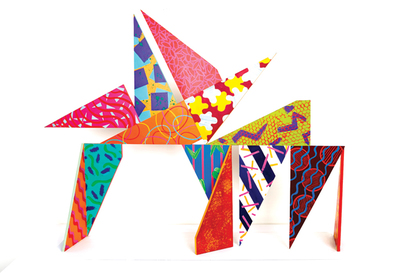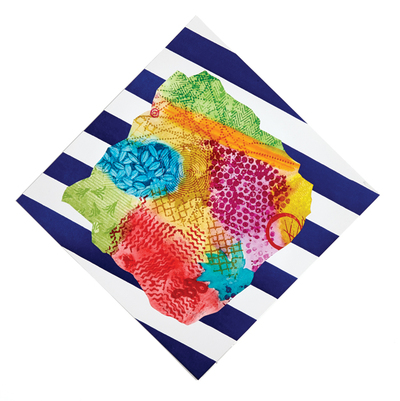Origami Interpretations: Artwork by Gloria Garfinkel; Above the Fold: New expressions in Origami
Gloria Garfinkel, Hanabi #5, 1994, maquette, painted aluminum, 29 x 39 x 9½”. Photo: Bill Mutter. Courtesy of Springfield Museums & Sculpture Garden.
Gloria Garfinkel’s provocative colors and patterns burst forth like firecrackers in her exhibit Origami Interpretations. Electrically hued designs, expressed as paintings, sculptures and collaged prints showcase the artist’s interest in the fashion and decorative motifs of Japan. Garfinkel’s kaleidoscopic palette and brazen ornamentation firmly unite her chosen themes and media. The intense, vibrant arrangements coerce the viewer’s eye to focus on many levels of patterns framed within larger geometric forms.
It’s likely Garfinkel cultivated her fascination with textiles when working in the fashion industry during the ’50s and ’60s. Following trips to Japan, Garfinkel said she became attracted to the “synergy of elegance and drama” evident in the kimono. In her collaged print series titled Ginkgo Kimono, she takes material with fan prints, bright stripes, basket-weaved lines and wood-grain patterns and adheres them to delicate Japanese paper. Like a tailor, Garfinkel neatly arranges her compositions inside a 30 x 30-inch square, often printing the same etching plates in different colors to achieve varying effects. The practice of recycling silk into new garments or accessories is common in Japan. Therefore, works such as Ginkgo Kimono #6, with its garment-textured patchwork of brilliant teal, peach, navy and red, is inspired by this custom.
The Hanabi series is comprised of freestanding aluminum sculptures that appear frozen in space, their surfaces painted with rhythmic designs. Although small in scale, Garfinkel’s intensely graphic sculptures command a monumental presence. The angular shapes within each sculpture create the illusion of folding paper, as if the process of making origami was halted halfway. Garfinkel skillfully reworks origami techniques into her sculptures, attentive to the meeting points of the patterns she chooses. Hanabi #8 combines triangular panels parading pink and chartreuse stripes, neon cubes and ellipses arching over a ruby background. The dual designs, painted differently on each side, allow the sculpture to change depending on the viewer’s orientation. Creases and seams surprisingly meet, and their contrasting colorations produce optical blending. The play of light in Garfinkel’s work is subtle yet intriguing. Cast shadows cantilever and overlap, gently surrounding the base of each Hanabi sculpture.
Gloria Garfinkel, Kiku #4, 1997, etching two layers on somerset texture white, handwork, 16 x 16″. Photo: Bill Mutter. Courtesy of Springfield Museums & Sculpture Garden.
Regardless of media, Garfinkel composes a compelling image from disparate parts. For example, her Kado series unifies two distinct fields of color. Kado #5, a woodcut accented with collage, joins a gold with an ocean blue. The curving contours of a seed design energetically clash against checkered mesh. Triangular snippets of collaged paper pull the two dissonant portions into one image. The adhered paper is also shaped like a dart—a sewing method used to alter fabrics. As seen in Kado #5, Garfinkel typically employs complementary hues, and her selection of opposing colors creates an unexpected, visual resonance.
Expect excitement and serenity in Garfinkel’s work. Abstract collages, such as Kimono Hanabi #6, use vibrant pigments and sharp diagonals to produce a kinetic frenzy. With sixteen colors and eight patterns, it is an audacious arrangement. In contrast, Kyoto Purple’s wispy gingko, delicate bamboo leaves and zigzag lines are overprinted in transparent violet and joined by a mint green border. Kyoto Purple’s limited palette and emphasis on texture suggest another dimension to Garfinkel’s exhibit. Origami Interpretations is a testament to Garfinkel’s adept application of color, repetition and design. Her compositions combine different Japanese aesthetics seamlessly in print, sculpture and painting.
The George Walter Vincent Smith Art Museum, in the Springfield Museums complex, is the perfect place to host Origami Interpretations. Its collection includes two floors of Eastern antiquities, including oriental rugs, Chinese porcelain, Japanese decorative objects, samurai armor and weaponry. The companion exhibition Above the Fold: New Expressions in Origami is also within the museum complex, in the Michele and Donald D’Amour Museum of Fine Arts. Above the Fold, curated by Meher McArthur, features nine international contemporary artists who work in large-scale paper installation. In its North American debut, Above the Fold serves as a “challenge to the viewer’s perception of traditional origami.” Although a centuries-old craft, the art of paper folding is still pushing aesthetic boundaries. Running the creative spectrum of representational to abstract, the exhibit includes tumbling cyclones of pleated paper to bas-relief style works, taking origami far beyond its initial origins. Both Origami Interpretations and Above the Fold will likely compel the viewer to consider the influence of Japanese decorative arts around the world and the remarkable artistic attributes of paper.


